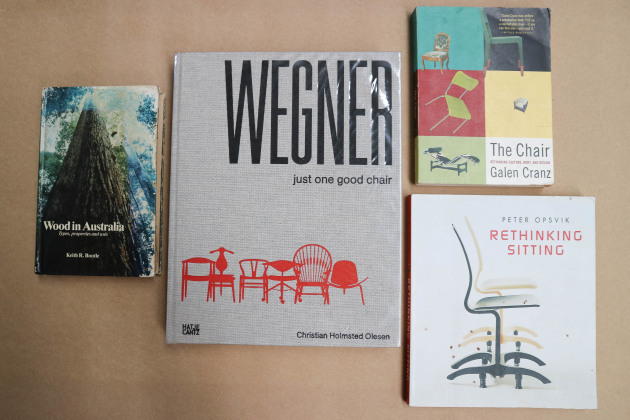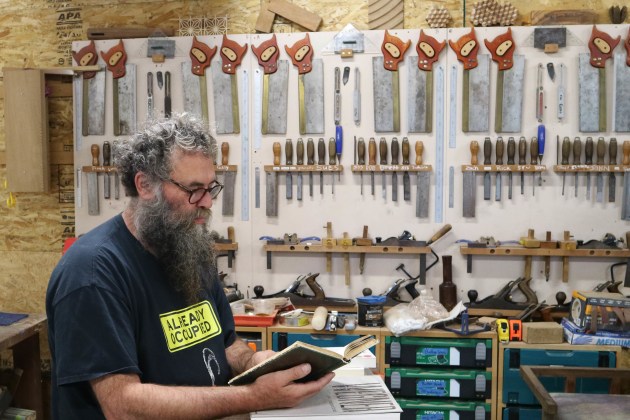Ross Annels: Recommended reading for woodworkers
Words and photos: Ross Annels
Ask a book loving woodworker to recommend a favourite woodworking book?
What a difficult task this is…my bookshelves are very full, and my reading is eclectic and always informing my practice.
So I thought I’d begin at the beginning. I grew up in forestry settlements in the South West of Western Australia – the forests are my first love, and the environmental campaigns around those forests were waged around the life and livelihoods of my family and neighbours, and as teenaged conflict over the kitchen table. I was destined to become a tree-hugging woodworker.
After many adventures in the world of higher education and the mainstream economy I began to take the idea of making things seriously. Studying with David Upfill-Brown inspired me to really focus on skill and on design focussed on the properties of our material – and so to the first book I would recommend to any woodworker in Australia is Keith Bootle’s Wood in Australia. The cover notes do a good job of describing the content: “provides a comprehensive summary of Australia's unique indigenous woods as well as other common species and explores the practices involved in producing, refining and using the different varieties of woods”.

Want to know about the process of harvesting and converting wood – it’s here. How trees grow – it’s here. What timber to use for a job – it’s here. How to dry wood – it’s here. How trees grow – it’s here. How to bend wood – it’s here. Tangential and radial shrinkage rates – it’s here. How hard, how durable, how heavy, how strong… you get the idea, a must have.
I admit to being seduced by design porn, especially chair porn. My shelves are full of books of pretty pictures of chairs, but like most forms of porn, they are ultimately unfulfilling – something is missing from those slick industrial forms, at least from my perspective. And I think that thing has a lot to do with the hand of a maker in conversation with a material they deeply understand. But aren’t there designers with a deep understanding of material? Our design education doesn’t really foster that kind of idea – but it has informed design in other places.
My next book reflects that: Wegner, Just One Good Chair by Christian Holmstedt Olesen. Wegner was a designer with a hands-on education in wood, and a true collaborator with the skilled makers who realised his designs. These are sublime chairs.
Pursuing my own interest in designing chairs I found myself wanting to understand more about how to make them work well for human bodies, in all our myriad of sizes and shapes, and for all kinds of tasks – chairs for working, for playing an instrument, for dining, for resting. Humanscale 1/2/3 is the book or rather, book like object, that I have found most useful to begin the process. It is uses a series of dials to give information on important ergonomic features for different sized humans and for different tasks.
Chairs are interesting objects in our culture – quite aside from questions of form and physical function, they carry all kinds of symbolic meaning. The throne, the stool, the bench… Trying to unpack these ideas, questions of the symbolic meaning of the object, leads to many interesting questions and opportunities for the designer maker – we can radically rethink the form of the chairs we make to sculptural or functional purposes, and consider the impact of the forms we make on the physical and psychological states of the people who use them. Two books deeply informed my thinking. Both present important challenges to standard ergonomic ideas about how to design chairs, and to our understanding of their role in our workplaces and homes: The Chair by Galen Cranz and Peter Opsvik's Rethinking Sitting.

Yes well that’s all very well and good Ross, but how do we actually do “that kind of design thinking”, to consider all of these different ideas about what is being conveyed by the things we make? We are just humble makers of things, and that all sounds very intellectual. My favourite book for tools to help unpack these kinds of ideas is, of course, written by a maker: Stephen Hogbin’s Appearance and Reality: A Visual Handbook for Artists, Designers and Makers.
Again the cover notes do a pretty good job “How can we design and make objects and images that actually do convey the meaning we intend them to have? How can we evaluate the success of our own creations and those of other people? This broad viewpoint helps the designer and maker step beyond modernism’s preoccupation with merely formal issues, and become able to create meaningful work that has cultural integrity.” It is full of pictures and really interesting diagrams drawing out the different aspects of our work. Highly recommended.
So my book recommendations are circling further away from questions of designing and making things to examining the context we design and make within, and how the things we make might enter into a conversation with that context.
Here in Australia, part of that context is our colonial history and how we understand our relationship to the land and its original culture. Read Bruce Pascoe’s Dark Emu, and Tyson Yunkaporta’s Sand Talk: How Indigenous Thinking can Save the World Just do it – read them!
Pascoe reinterprets colonial and explorer accounts and cultural artefacts to make a compelling case for Aboriginal resource management and agriculture that is very different than the one I learnt in school. Yunkaporta’s book argues that Indigenous thinking is different, embraces complexity and context and uses pattern based thinking to understand the world. He asks what happens if we bring this kind of thinking to the big picture questions that the world is facing around sustainable life.
And that brings me back to myself as tree-hugging woodworker. My old friend and philosopher Glenn Albrecht coined the word Solastalgia – “the homesickness you have when you are still at home”. It’s about the lived experience of negatively perceived environmental change. I’m sure many among the woodworking community know this feeling. But how can we address this deep sadness?
My final two book recommendations have helped me think about our relationship with/within the world we inhabit, one of them a work of insightful scholarship, the other a fictionalised drawing together of much of the new science around trees forests and communication. In The Spell of the Sensuous, Dave Abrams argues for the reanimation of the “more than human world”, rebuilding a fully sensuous, communicative relationship with our world – it’s a deeply evocative work. Lastly, to whet your imaginings, The Overstory by Richard Powers, a novel for tree and forest lovers.
Ross Annels is a designer maker living and working in Kabi Kabi lands on the Sunshine Coast. He holds classes and workshops at Lomandra Place Studios in Coolum Beach. Learn more at www.lomandraplacestudios.com



